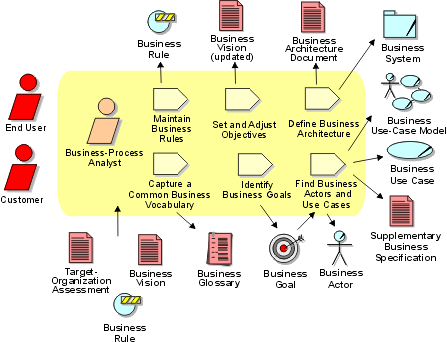Workflow Detail: Identify
Business Processes
|
The purpose of this workflow detail is to identify and prioritize business processes that need detailed descriptions. |
|
|
|
Description

Within the team, you need to come to a common understanding of the boundaries of the organization that you are describing and decide which processes you will need to describe in more detail.
The purpose of this workflow detail is to:
- Decide on terminology.
- Identify business goals that support the business strategy.
- Outline the business use-case model.
- Prioritize which business use cases to describe in detail.
This workflow detail starts with identifying the current Business Goals. This is done somewhat in parallel to refining the existing Business Actors and Business Use Cases to reflect the target organization (to-be situation). Depending on the scope of the business-modeling effort defined in the Business Vision, the existing business actors and business use cases might be used as a starting point and refined or completely rethought.
Business use cases are detailed just enough to understand their impact and prioritize them. In practice, a rough outline of each business use case should be adequate. Where quantitative or qualitative requirements (such as minimum throughput or adherence to standards) that govern the behavior of the business use cases are uncovered, they must be documented in the Supplementary Business Specifications.
Commonly used terms and definitions must be captured in the Business Glossary. Any business rules discovered during this process must be documented in the Business Rules.
Based on the business-modeling objectives as defined in the Business Vision, the business use cases are prioritized, and the Business Process View of the Business Architecture Document is updated with the (adjusted) architecturally significant business use cases.
Related Information 
This section provides links to additional information related to this workflow detail.
Timing 
Begins in Inception phase, repeated in later iterations as required/planned.
Optionality 
Recommended for business modeling efforts aimed at engineering or re-engineering a business.
How to Staff
Your business-modeling team (all acting as business-process analysts) invites representatives of the stakeholders to the modeling effort. This extended business-modeling team must have a strong understanding of how the business currently serves its customers and of the direction that the business is taking. The core team needs to have detailed knowledge of the business-modeling techniques and good facilitation skills.
When re-engineering a business, this workflow detail means that you are effectively deciding who your new customers will be. This means that the individuals who have the power to make such decisions need to take part in this effort, either as active members of the modeling team or as stakeholders.
Work Guidelines
Conduct a workshop in which the goal is to decide on terminology and outline the business use cases and business actors. The following sample techniques can be applied to help you collect the correct and relevant information:
This content developed or partially developed by  Empulsys BV. Empulsys BV.
|

